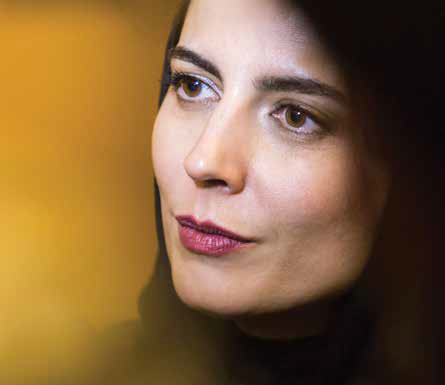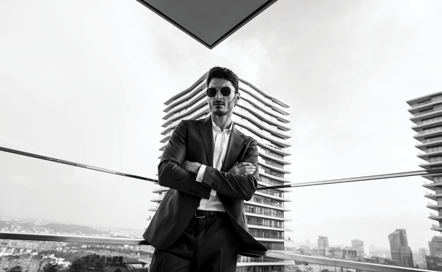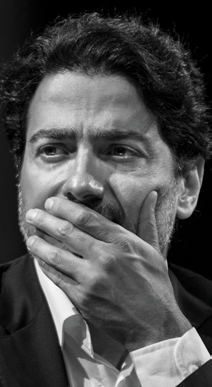
My name is Sara Ghanbari, nicknamed Shamim, and I was a graphic design student at the University of Science and Culture in Tehran. As a sophomore, I spent most of my time practicing photography, where I discovered my inner calling.
I continued photography across various fi elds, delving into fashion, portraits, cinema, music, and even working on documentaries. For the past 15 years, I have immersed myself in the captivating world of photography, passionately capturing moments through the intricate sieve that is my innermost being. Through different lenses, I unveil the depths of my mind, the essence of my spirit, and the resplendence I perceive in a variety of shapes and settings.
To pursue such a path, external encouragement and inspiration are essential. For me, the person who inspired me most, in every conceivable aspect, was Paris’s Damandan. To this day (in my opinion), she remains the sole person to be a true master of all aspects in photography and lighting. Diffi culties are common in our lives;

however, to grow and become stronger, we have to overcome these problems. My two biggest challenges have been earning suffi cient money from photography alone and the censorship of ideas that limit my creativity.

The only celebrity who I felt wanted to passionately convey emotions and a message to the audience through the camera was Navid Mohammadzadeh, and I would say the person who was most patient and without pretense in front of the camera was Homayun Shajarian. When it comes to photographing celebrities and artists, the most important obligation for me as a photographer is to capture their inner feelings and expressions to convey this to the intended audience. It is important to remember there is more behind the lens than meets the eye. I tell the tale of the truth, what is real, and when I’m shooting, I attempt to capture the true personalities of my subjects. From my experience with famous people, I learned how to respect their privacy, see their humanity, and never use them as a tool.
Instead, I prioritize the values of the artist before the subject matter that I want to portray. Professional artists have a good sense of the artistic process, and given their talents, their utmost comfort lies in front of the camera. However, there is a duality that I should be cautious of, which is the fact that regardless of the fame of the subjects, to capture their real personality, I should view them as ordinary human beings.
An insightful memory during my work was the reaction of a famous actor I had the pleasure of working with. His professionalism while we were working together was impressive. Later on, he informed me he wasn’t as comfortable as I assumed in front of the camera, and it was because he disliked the idea of coming across as a professional model.

I still haven’t worked with AI apps, rather, I believe it questions the nature of photography, although I do think AI is a tool for visualizing ideas and capturing shots that would otherwise take too long to prepare for in a presentation. A shortcut, AI is a tool that lessens the burden of diffi culties. AI is amazing, it can run, present, or demonstrate unrecorded ideas, capturing art in a modern perspective. By taking out the unnecessary time and effort, it allows photographers and artists to focus on their intuition, originality and art.

My preference when choosing the type of photography relates to my interest and gravitation towards that particular project, but most importantly, the joy I feel it will bring me. I am always joyful about the types of projects I choose to work on. I love fashion photography, and I believe portraits can also be considered a part of the fashion perspective through makeup, the type of skin, and the feeling viewers sense from the photo. There are diverse intersections constantly occurring in photography; fashion can be art, and portraits can be fashionable—this is the beauty of the photography world.
Fashion is a concept that can be infl uenced not only by modern environments but also natural environments. Anything and everything in life can use a touch of fashion. For example, when I look at nature, I feel that God is really the greatest fashion designer of all. Sometimes, decorating and designing happen deliberately, while in other cases, it can occur in clutter or in emptiness, in different places like a village or in nature. We can sense and view fashion everywhere; it is a point of view that, as a photographer, I can fi nd myself.
It is essential to understand the nature of the subject when researching lighting and proper framing. The correct transmission of the message from the subjects to the viewer is witnessing what others may not be able to see.
Last but not least, what is a piece of advice you would give to individuals just starting out in the photography industry or with photography? With my 15 years of experience, I had the opportunity to learn that I can see the beauty in a frame, regardless of whether others see nothing or emptiness/ugliness. I would like to thank Trends magazine for this wonderful conversation, fi lled with intriguing questions.

Opening Hours:
24/7
Address: Tradex Mena International Consulting Group L.L.C-FZ 6th Floor, Business Center, The Meydan Hotel Grandstand, Meydan Road, Nad Al Sheba, Dubai, United Arab Emirates
+971 50 240 9735
Address: TRADEX INTERNATIONAL CONSULTING DANIŞMANLIK
itH. iHr. ve TiC. LTD. ŞTi.
Tomtom Mah. istiklal Cad. Beyoğlu iş Merkezi No.187 iç Kapr No: 4 Beyoğlu/iSTANBUL Beyoğlu V.D. 8591125255